Please Take Note: This is a review of the final game, but it might change slightly based on the success of the Kickstarter campaign. The game is being reviewed on the components and the rules provided with the understanding that “what you see is not what you might get” when the game is published. If you like what you read and want to learn more, we encourage you to visit the game publisher’s website or visit the Kickstarter campaign. Now that we have all that disclaimer junk out of the way, on with the review.
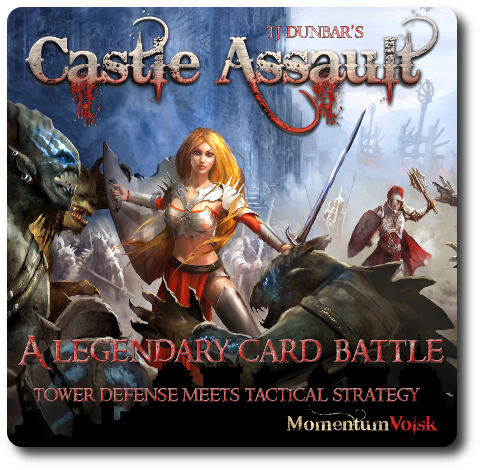
The Basics:
- For ages 10 and up (publisher suggests 13+)
- For 1 to 2 players
- Approximately 60 minutes to complete
Geek Skills:
- Active Listening & Communication
- Counting & Math
- Logical & Critical Decision Making
- Reading
- Strategy & Tactics
- Risk vs. Reward
- Hand/Resource Management
Learning Curve:
- Child – Moderate
- Adult – Easy
Theme & Narrative:
- Assault your enemy’s castle and burn it to the ground
Endorsements:
- Gamer Geeks approved!
- Parent Geeks approved!
- Child Geek approved!
Overview
Essayist George Santayana said, ” Only the dead have seen the end of war.” In the real world, yes. War is horrific. In a fantasy world and on your gaming table, this is not the case. War in games gives players an opportunity to flex their tactical muscle and strengthen their strategic mind. Wargames do not celebrate war, but look to analyze, understand, and recognize what war is truly about. In this game, you will be confronted with a single task and a tenacious adversary. Victory will go to the player who knows that sacrifice is necessary to win.
Castle Assault, designed by TJ Dunbar and to be published by MomentumVolsk, will reportedly be comprised of 1 Battlefield board (a 20″ x 30″ 6-fold game board), 34 Orc Faction cards, 34 Elf Faction cards, 34 Human Faction cards, 34 Undead Faction cards, 27 single-player campaign cards, 4 Hero cards, 1 book of stamps to customize Hero cards, 16 Factionless cards, 3 “12mm” six-sided dice, 2 “16mm” six-sided dice, 5 glass counters, 2 Soul glass counters, 1 Heavy Armor glass counter, 1 Arcane glass counter, and 1 Discard glass counter. As this is a review of a prepublished game, I will not comment on the game component quality. The artwork provided with our demo copy of the game was excellent. A large number of people contributed to the illustrations found in Castle Assault. Each faction is depicted in a unique way, further reinforcing the game’s theme and narrative. The talents of Jared Blando, Cryssy Cheung, Christopher Clements, Kevin Falkenberg, Ken Huntley, Guillermo H. Nuñez, Betsy Peterschmidt, Will Pottorff, and Benita Winckler bring the world of Castle Assault to life, making it easy to imagine the armies on the battlefield.
Game Set Up
To set up the game, first place the Battlefield mat in the middle of the game playing area.
Second, each player should now assemble a Faction deck made up of at least 30 cards and no more than 40 cards (or whatever number both players agree on). Any cards not used should be returned to the game box.
Third, place a counter on the “10” space value on the Castle Health track.
Fourth, place a counter on the “Start” space next to the Momentum Meter track.
Fifth, each player shuffles their Faction deck and places it face-down in front of them. Each player draws the top 5 cards from their draw deck to create their starting hand.
Sixth, each player then rolls 1 six-sided die. The player with the highest number can choose to go first or go second (as there is an advantage to both).
That’s it for game set up. Time to burn a castle!
Faction Card Anatomy
There are 3 types of cards in Castle Assault. These are “Unit”, “Ability”, and “Resource” Faction cards. “Unit” and “Ability” Faction cards are summarized here. “Resource” Faction cards are explained later in the review.
“Unit” Faction Cards
“Unit” Faction cards represent the men, women, things, and contraptions that are leading the charge and swinging weapons. Everything from flying goblins to giant dragons is represented by the “Unit” Faction cards. While the armies of each Faction are very different, each “Unit” Faction card has the same layout making it easy for a player to switch Factions without having to relearn the game.
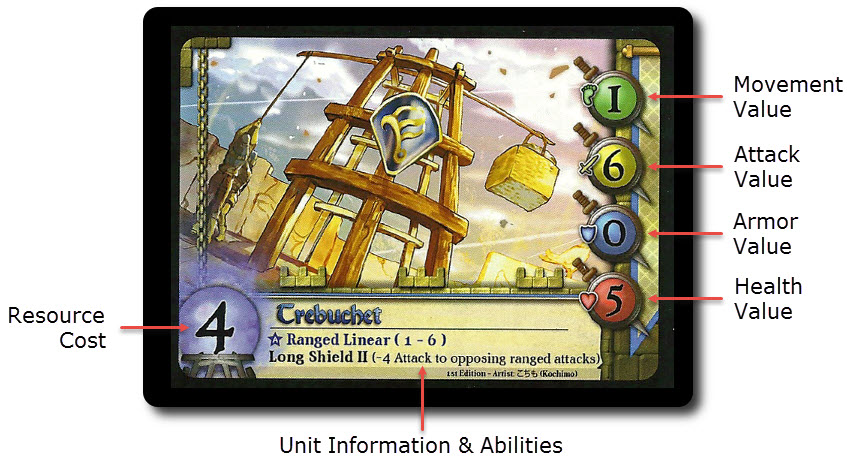
“Ability” Faction Cards
“Ability” Faction cards add bonuses, equipment, bend, and break the game’s rules. “Ability” Faction cards leverage the strengths of the Faction in which they belong and make them even stronger. Some “Ability” Faction cards are used once while others are permanently attached to a “Unit” Faction card.
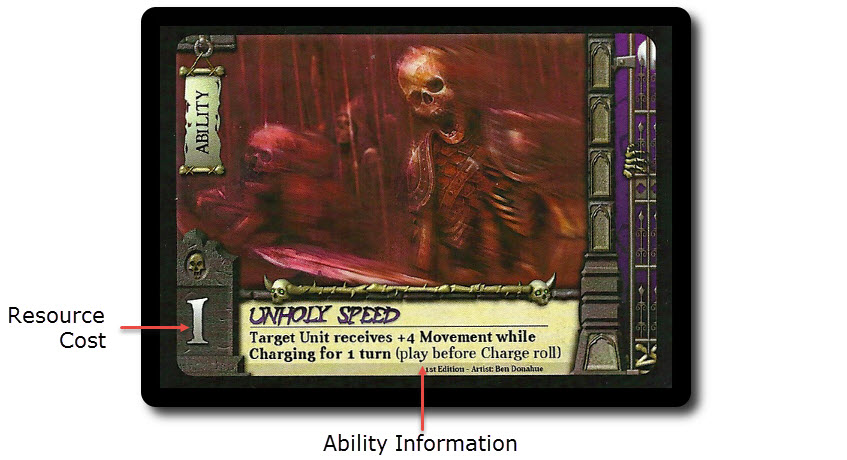
There are also “Ability” Faction cards that do not belong to any specific Faction. These look almost identical to the Faction specific “Ability” cards, but are noted as “factionless”. These can be added to any player’s Faction deck of cards as long as the total number of cards in the Faction deck does not exceed the maximum. When tailoring a Faction deck, the only four rules that cannot be broken are as follows:
- Total number of cards in the Faction deck cannot exceed the agreed upon maximum (normally 40)
- A Faction deck can be comprised of 1 Faction and factionless cards
- No more than 2 copies of any Faction and factionless cards are allowed in the Faction deck
- Only 1 “Epic” Faction card can be added to a Faction deck
The Factions, So Far…
Our copy of the game came with 4 Factions. Each Faction deck contained 34 cards and was a mix of “Units” and “Abilities”. Each of the Factions are summarized here and should be viewed as a summary of what will be provided in the game, but not in its entirety.
The Kingdom of Men
Mankind takes the art of war seriously. Siege weaponry is built to tackle the most difficult of foes and the troops holding the frontlines are well armed and armored. Ranged combat is essential to victory, but also the use of magic. The Kingdom of Men has a little bit of everything, making them a worthy foe and a likely victor if their enemy comes unprepared.
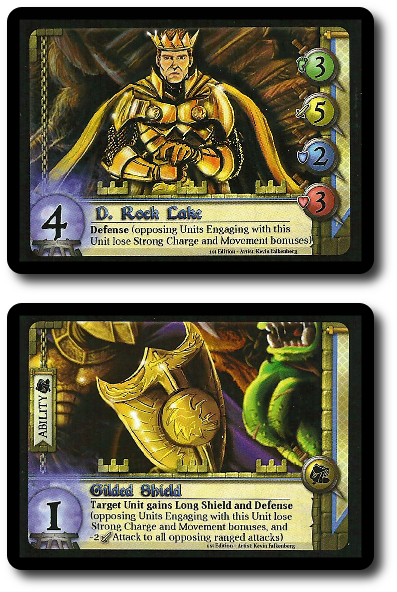
The Hordes
The Hordes are comprised of small groups of disorganized hobgoblins, trolls, ogres and other ilk. They know nothing of honor, but respect fear and strength. Lord Garrulk has brought the Hordes under his control and is now directing them to pillage and burn the land. The Hordes’ strategy is a simple one: move quickly and hit hard.
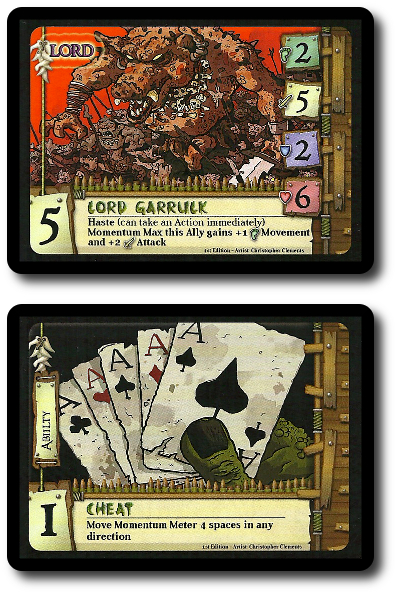
The Vampire Courts
In a distant land, the undead rule over all. The Vampire Courts watch towns and villages like a rancher watches his livestock. For hundreds of years, the vampires of the land were content to feed and live out their endless existence behind their castle walls. But no more. A new campaign has started with a single goal in mind: expand the Vampire Courts. Now every kingdom is in danger as the vampires look to sink their teeth into new territory.
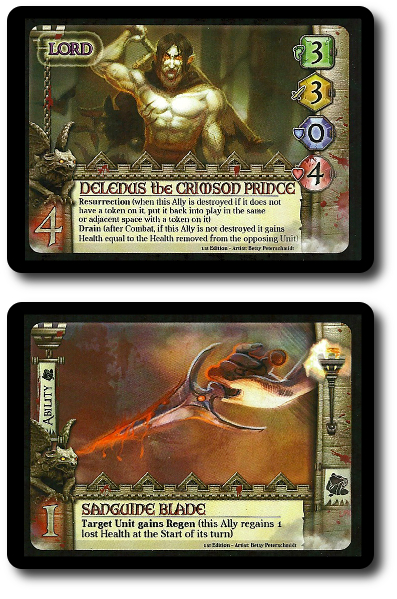
The Undead
There is no rest for the fallen warriors who gave their lives for their leaders. They now walk the earth answering the command of a different master who is hellbent on burning the world. The undead are to be feared, as they are hard to destroy. Many resurrect after they fall and some can even turn into mist, evading all forms of weaponry. Every battle, win or lose, adds to the ranks of the undead, making them a dangerous and deadly enemy.
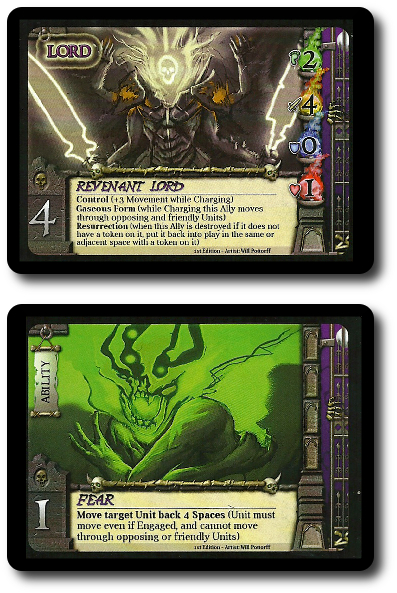
To War!
Castle Assault is played in turns with no set number of turns per game. A player’s turn is summarized here and is organized into phases. However, the individual actions the player will take will always depend heavily on what cards they have in their hand, what cards they have in play, and the ever-changing conditions of the battlefield. As such, some of the steps and actions in each phase might be skipped since they are not possible or not within the player’s best interest to attempt.
Phase One: Start of Turn
The first phase of a player’s turn is the same for both players. In fact, players will never skip the first phase of their turn, but they might skip a few of the steps within the phase. Each step must be completed in sequential order.
Step One: Roll Momentum
Momentum measures the shifting tide of advantages and disadvantages found on the chaotic grounds of battle. It’s something of a tug-o-war between the opposing forces as morale is lost and gained through skirmishes, successful charges, and failed advances. In game terms, Momentum provides a player a +1 Attack bonus on their turn, but only if the Momentum is clearly in their favor. To determine if it is, the player takes a single six-sided die and rolls it. They then move the Momentum counter towards them on the Momentum Meter track a number of spaces equal to the number rolled. If the player doesn’t like what they rolled, they can always change their fortune with a card or two.
Step Two: Ready Exhausted Resources
If the player used “Resource” Faction cards, they can now tip them back to their ready position indicating that they can once again be used.
Step Three: Draw One Card
The player now draws 1 card from their Faction draw deck, adding it to their hand. Player’s shouldn’t be too concerned if they are drawing nothing but cards that are too costly to bring into play. Every card drawn is useful, since every card can be made into a “Resource”.
Step Four: Start of Turn Effects
Some Faction cards have a “Start of Turn” effect listed on them, which is noted in the card’s Ability area. Only those cards in play can use this effect. If any card does have this effect listed, the player can make use of it now.
Step Five: Move Units and Attack
All in play “Unit” Faction cards can now be moved through the battleground. Each “Unit” can be moved a number of spaces on the grid equal to the “Unit” Faction card’s Movement value. Movement is mandatory and it’s always towards the opponent’s castle in a straight path. This is a game, after all, about assaulting a castle and burning it to the ground. Everyone moves forward.
When moving “Units”, the most forward (i.e. the “Unit” Faction cards closest to the opponent’s castle) must move first, followed by the next most forward, and so on. When two or more “Unit” Factions are at equal distance and could both be considered the most forward “Unit”, the player can decide which moves first. “Unit” Faction cards cannot move on top or through each other. Nor can an enemy Faction move into the player’s castle area. They can attack its walls, however.
There are two major types of movement. The first is taken during this phase of the player’s turn. If the “Unit” Faction card bumps up against an enemy Faction (thus ending its movement), it receives a Strong Movement Bonus. The other is “Charge” ability, but it’s not used at this time during the game.
If a “Unit” Faction moves and ends theirs movement in front of an enemy Faction, combat ensues. Faction cards that are next to each other are said to be “Engaged”. “Unit” Faction cards can also “Engage” their opponent’s castle wall, which is the primary way to win the game. When a “Unit” Faction card “Engages” an enemy “Unit” Faction card through movement, they get the Strong Movement Bonus which gives them a bonus during combat. “Unit” Faction cards cannot attack enemy “Unit” Faction cards that are adjacent, although certain Abilities require a Faction card to be in such a position in order to be targeted.
Combat is done using a quick calculation of the attacking “Unit’s” Attack value minus the defending enemy “Unit’s” Armor value. The difference is the number of Health that is lost. Bonuses are applied during the calculation. Castle walls always have a base Armor value of “zero”, which makes them an easy target and is why it’s always a good idea to defend your castle walls.
Engagement between enemy Factions is always resolved at the time they become engaged. This means a newly placed “Unit” Faction card immediately “Engages” an enemy “Unit” Faction card that is on the other side of the castle wall. “Units” also trade blows a total of 2 times each when they “Engage”. This back and forth reduces the “Unit” Health values each time combat takes place, almost always resulting in 1 “Unit” being discarded. Castle walls are the exception to this rule. Players can only attack a castle wall once, but there is a fun little loophole.
Ranged combat is also possible in the game, be it with siege weapons, bows, or magic. Ranged combat can be linear (straight head towards the enemy’s castle wall) or adjacent. Ranged combat has a printed range. These numbers indicate how many spaces away the target can be. It’s impossible for players to shoot (or even target) their own “Unit” Faction Cards, which makes shooting over friendlies a simple task, but the target must be within range. With Ranged combat, players can even launch a barrage of arrows over enemy and friendly “Units” to strike a target further down the battlefield. Best yet, striking an enemy “Unit” from a distance means no counter-attack!
Phase Two: Open Play
The second phase of the player’s turn provides options. None of which need to be taken, by the way. Phase One and Three of a player’s turn are full of required actions and steps. Phase Two focuses only on a player’s tactics and strategy. Both of which are heavily influenced by the cards they have in their hand, the cards in play, and the faction they are playing as. The following Options can be taken in any order the player likes.
Option A: Place Resource
Every card a player has in their hand and in their Faction draw deck is a possible “Resource”. “Resources” are used to bring into play “Unit” and “Ability” cards. They are the “fuel” that allows the player’s army to go kick butt. Once per turn, a player may select 1 card from their hand and place it face-down in front of them. This area is referred to as the “Resource Area” (for lack of a better name). No matter what the card type is or how powerful it could be, it will only ever be worth 1 “Resource” once it’s played to the Resource Area. As such, players should give some thought into what they are placing. While the card can be used to bring forth other cards, it can never be recovered from the Resource Area once placed.
During the first turn of the second player, a maximum of 2 “Resource” Faction cards can be placed. This is a one time bonus and gives the second player the ability to quickly catch up to the first player’s army.
Option B: Play Units
If the player has a “Unit” Faction card in their hand they want to play, they must be able to pay for it using the “Resource” Faction cards in their Resource Area. If they can, they tilt a number of “Resource” Faction cards equal to the “Unit” Faction card’s Cost value. This indicates that the “Resource” Faction cards have been used for this turn. The “Unit” Faction card is then placed in any free space behind the player’s castle wall. This “Unit” Faction card cannot take any other actions during the player’s turn. However, some “Unit” Faction cards have special abilities that allow them to be used as soon as they come into play.
A player may bring more than 1 “Unit” Faction card into play if they have the “Resource” Faction cards available to spend.
Option C: Play Abilities
“Ability” Faction cards can be used to augment “Unit” Faction cards in play. Some “Ability” Faction cards can be paid for using the “Resource” Faction cards whenever required. Others can only be played during this phase of the game
If the “Ability” Faction card provides a bonus, it’s now active and temporarily attached to the “Unit” Faction card the player targets. Once the “Ability” Faction card is used and resolved, it’s discarded. Other “Ability” Faction cards are permanently attached to “Unit” Faction cards and stay with the “Unit” Faction card until the “Unit” falls in battle. In which case, the “Unit” and “Ability” Faction card are both discarded.
Like playing “Units”, a player may bring more than 1 “Ability” Faction card into play if they have the “Resource” Faction cards available to spend.
Option D: Take Unit Actions
All “Unit” Faction cards the player has in play, except those that were brought into play this turn, can now take an action if the player likes.
By default, most (not all) “Units” Faction cards have the Charge ability. This ability is not noted on “Unit” Faction cards because it’s common. The Charge ability allows a “Unit” Faction card to move a maximum number of spaces equal to a rolled value on a six-sided die. This is in addition to the Movement value noted on the “Unit” Faction card.
All “Units” may also Attack as an action. This allows players to attack castle walls twice if they can manage it. Once when they moved to the castle wall and once again as the “Unit’s” action.
Any Abilities noted on the “Unit” card can also be used at this time.
Phase Three: End of Turn
The player’s turn is almost over, but first there is a little bit of administrative work to be done.
Step One: End of Turn Effects
Like the “Start of Turn” effects, some Faction cards might have an “End of Turn” effect listed. If they do, the effect is now triggered and resolved.
Step Two: Discard
Finally, if the player has more than 6 cards in their hand, they must discard down to 6. The cards removed are placed in the discard pile.
This completest the player’s turn. If the game has not ended, the next player now takes their turn starting with Phase One noted above.
Victory on the Field of Battle
Castle Assault ends one of two different way.
The first, and most common, is that one of the player’s lose their castle. Once the Castle Health counter reaches “zero” on the track, the player’s castle has fallen. Without means to protect themselves or launch an attack, the player’s faction has lost the battle.
The second is a bit longer and is, in my opinion, a bit anti-dramatic. If a player draws their last card, they continue to play and are forced to always play 1 card per turn whenever they are able to. Eventually, the player will be unable to reinforce their army and play new cards. In which case, the field belongs to their opponent by default. However, if both players run out of cards and opposing “Unit” Faction cards are all removed or locked in a stalemate, whichever player has the highest Castle Health value wins the game. Ties are broken by rolling a six-sided die, with the game going to the player with the highest roll.
Game Variants
Single-Player Campaign Play
Castle Assault comes with a solitaire game variant. The game play is almost identical, with the player acting as the leader of their Faction and resolving the enemy Faction cards. The games are broken into scenarios that are part of a larger campaign. Each scenario is essentially a battle in the war, but with a story. The player works towards a specific victory condition in each scenario that will allow them to win immediately if it can be obtained. It also serves to strengthen the campaign’s story. Another deck of cards is used for game play to represent the opposing forces and a special Hero card is introduced that grows stronger after each scenario is completed.
Stuff We Didn’t Cover
Oh, lots. Each “Unit” Faction card is pretty unique, providing something the other “Units” do not. In the interest of time, let’s just leave it at this: The game is driven by the cards and the cards have been designed to represent each unique “Unit” and “Ability” so they standout and are useful. To really understand the game, you have to play it and then play it again and then one more time just to make sure.
We also didn’t cover the single-player campaign and the Hero cards. Not because we didn’t want to, but because we were not provided them. From the description of play and of the cards to come, both sound very interesting and had all of our players excited.
To learn more about Castle Assault, visit the game publisher’s website or visit the Kickstarter campaign.
Final Word
There was a bit of a learning curve for the Child Geeks when it came time to play Castle Assault. To the game’s benefit (and everyone’s delight), players are not required to understand the “whole game” before they sit down and play. In fact, it’s better if they don’t. The core rules focus on movement and attacking, which is well over half the game. Everything else in the game will be introduced and augmented by the cards played. Which was a problem for the Child Geeks. They got lost in the cards, forgot when to play Abilities, and sometimes focused a bit too much on the immediate concerns rather than their long-term goals. According to one Child Geek, “I keep getting lost, but only because I’m eager to bring out more cards.” All this really meant is that the Child Geeks had to be reminded of rules often, helped more than usual, and kept on task as they had a tendency to want to just read their cards rather than play the game. None of which, I must add, reduced the Child Geek’s level of entertainment. They loved the game. Loved. It. Whether it was looking through the cards, discussing how monsters should attack. or actually playing the game, the Child Geeks had a blast. One Child Geek said, “This reminds me of Summoner Wars, but is better because it reminds me of miniature battles, too.” Another Child Geek interrupted and said, “No, this is like Magic: The Gathering and Memoir ’44.” The Child Geeks continued to argue about what the game was like, but they all agreed that Castle Assault was a game they enjoyed.
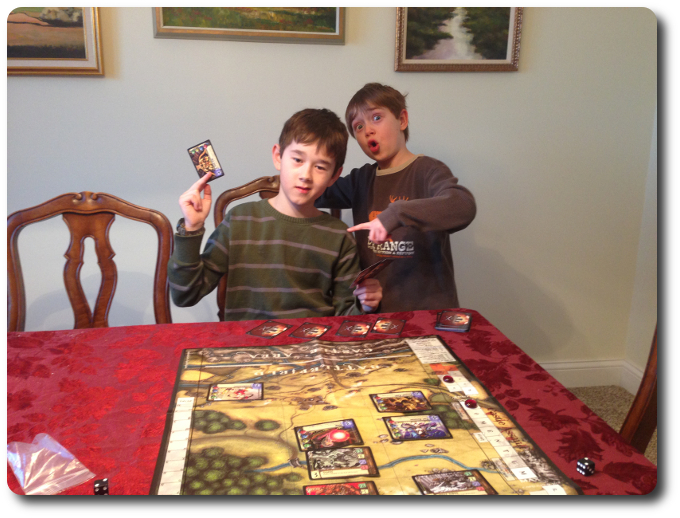
This is what I saw seconds before my oldest son tore my army apart…so *sniff* proud….
The Parent Geeks liked playing the game on two levels. The first was with their Child Geeks. One Parent Geek said, “It’s an easy game to set up and enjoy with another person.” Another Parent Geek said, “This is perfect for me. I play Chess and Checkers a lot with my kids. This is going to be the next step!” The second was with their peers. This is where the games really heated up and the Parent Geeks who had long wanted to play miniature based wargames and loved card games came into their own. One excited Parent Geek said, “This has everything I’ve been looking for. It’s challenging, I can play it by myself, I can easily teach it to a friend, and best of all, it’s always a different game.” The only part of the game that was not well liked was the rule book, which everyone found confusing. One Parent Geek said, “It’s hard to understand at first, with all of its examples, but you can learn how to play it just by reading the rules.” When all the games were over and votes were collected, the Parent Geeks enthusiastically endorsed it.
The Gamer Geeks were impressed with the game’s ability to allow the player to adapt to the battlefield, but were not immediate fans of the linear combat. According to on Gamer Geek, “I don’t like the fact that I cannot move to my left or right. That seems stupid to me. Why are my guys just running forward?” When I explained that the idea is to assault the castle, not win the battlefield, the Gamer Geeks relaxed a bit. Another issue the Gamer Geeks didn’t particularly care for was the movement during 2 different phases of the game. One Gamer Geek said, “I understand the rule and I think it works, but it feels goofy that I have a charge move during one phase and a regular move during another.” None of the Gamer Geeks thought the Momentum bonus wasn’t all that exciting, but they never complained when they used it, either. All the Gamer Geeks found the different Factions to be predictable, but enjoyable to play with. They also found the game to be very well-balanced, giving victory to the stronger player, not the luckiest. One Gamer Geek said, “A solid game. The rule book is total junk, but once you learn how to play the game, it’s impossible to have a bad time.” Indeed, all the Gamer Geeks found the game to be a lot of fun and voted to approve Castle Assault, finding it loaded with a lot of things they liked and only sprinkled with a few things they didn’t.
Let’s get the obvious question out-of-the-way first. Is Castle Assault like Summoner Wars?
Yes, it’s like Summoner Wars in the sense that players have different factions which can be customized, combat is done by moving cards on a grid battlefield, use of tactics and strategy is necessary to get the upper hand, and bringing forth units by spending some sort of resource is required.
No, it’s not like Summer Wars because game play focuses much more on units, augmenting unit abilities, taking advantage of the battlefield conditions, and pressing hard in attacks to destroy the primary goal. Summoner Wars is more focused on arena-like combat, where Castle Assault makes use of the space provided by a large battlefield.
“Similar but different” was a term used often by our players, and for those who owned Summoner Wars, it didn’t make a bit of difference. Both games provided a unique game play experience and stood on their own. One player suggested that comparing the two games together was like comparing oatmeal and Malt-O-Meal. “It’s all about which you prefer, but either will fill you up with warm goodness.”
Personally, I find Castle Assault’s style of play to be much more satisfying than any other card-based tactical combat wargame I’ve played in sometime. The game’s focus is all about stopping incoming threats while sending out your own troops to threaten your opponent. A few of our players mentioned that Castle Assault felt like a tower defense game. I totally agree. You can see the threat coming and you know what you have to do to stop it, but that’s only a third of the battle. The second third is actually stopping the wave of enemies before they knock down your walls. The last third is the most fun. After you get attacked, you can send your own forces into the battle. What makes the game so interesting is that the battlefield between the two castles is where you play out strategy and tactics between players to see which gets to continue to the castle wall and which gets buried in the ground. That’s strangely satisfying.
Castle Assault is excellent fun. I’ve played all the Factions and I have yet to really feel like I’ve played the entire game. There are so many combinations to try, so many conditions to counter, and countless ways to get attacked. It’s a game I found myself thinking about well after I put it away, which is always a good sign. If you enjoy tactical and strategic game play, tower defense games, and diving into a game with a lot of replayability, do storm the gates of Castle Assault.
This is a paid for review of the game’s final prototype. Although our time and focus was financially compensated, our words are our own. We’d need at least 10 million dollars before we started saying what other people wanted. Such is the statuesque and legendary integrity of Father Geek which cannot be bought except by those who own their own private islands and small countries.



